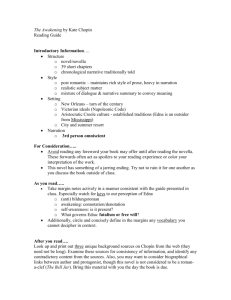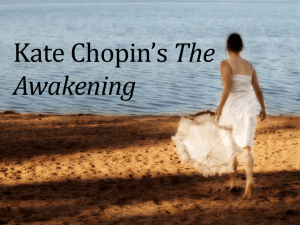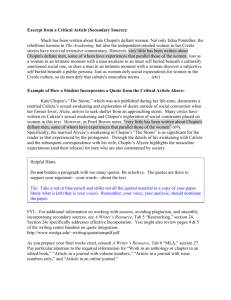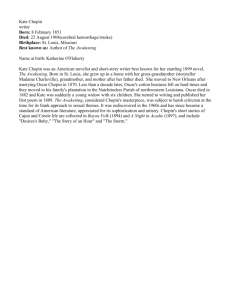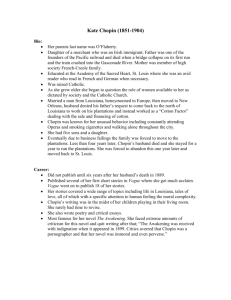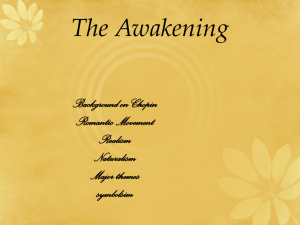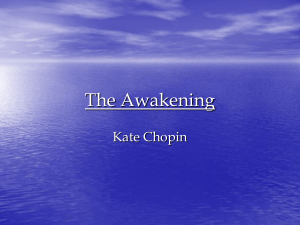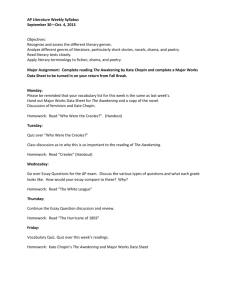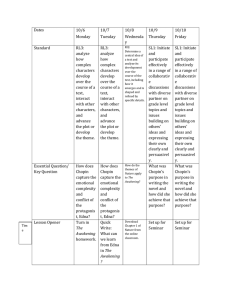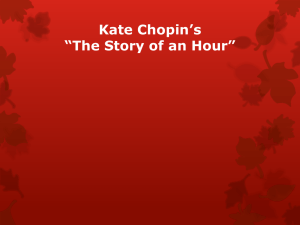Chopin Powerpoint
advertisement
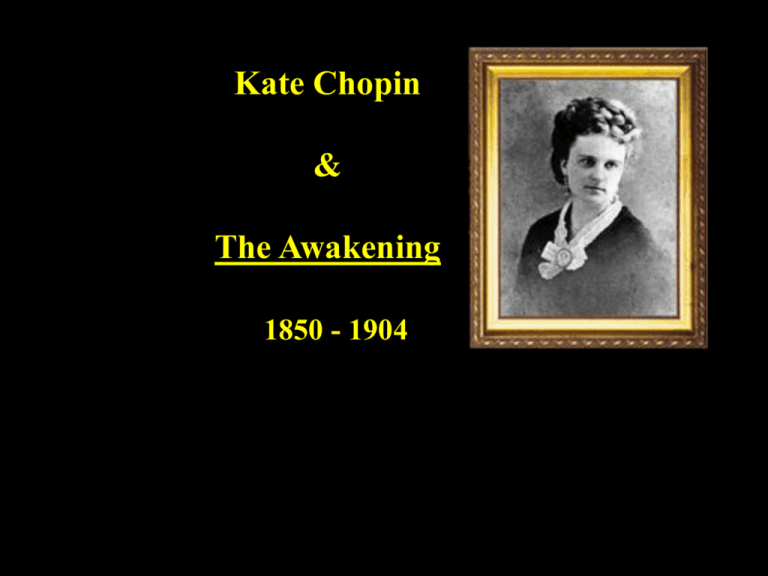
Kate Chopin & The Awakening 1850 - 1904 Chopin's major work was published in 1889. - well-established as a national writer - it was reviewed by critics who universally condemned it as "shocking" and immoral PLOT It is the story of a young woman’s gradual awakening. - sexuality - individual "being" - longing for an independence - suicide She was very important as one of the earliest examples of modernism American Literature. Romantic elements & The Awakening - the exotic locale - use of color - heavy emphasis on nature - romantic theme: individuality and freedom - rebellion against society and death Edna - two extremes in life - completely alone = romanticism & - frequent inner thoughts - memories of childhood - the personified sea (nature) - the mysterious woman in black - the romantic music, dinner party - desire to express herself Naturalism & The Awakening - Edna as hostage to her biology - She is female (children & wife) - society dictates behavior - "no attempt to suppress her impulses" - welfare of her children Local Color & The Awakening - characterizations of the people - the descriptions of places - fundamental meaning of the story - Creole society and its social mores - women making choices that create a life STYLE: Chopin interested in how one tells the story as the story itself. Perspective – multiple Point of view Imagery Appearance in reality: - seen in the New Orleans experience - things are not always what they seem - things are different to different players. All of these formed her style - theme based - her stories were very short - she was experimenting with style Women’s Rights: - Chopin: was not a feminist nor a suffragist - took women extremely seriously - due to her background (mother …) - - lack of interest in feminism and suffrage: she simply had a different understanding of freedom. - Freedom = “character of living your life within the constraints that the world makes [or] your God offers you, because all of us do live within constraints.” Religion: - influence of Catholicism - she promoted the idea that every human person could be excellent and valuable Social Classes: - Black v. White - Rich v. Poor - Male v. Female - comfortable with difference - part of life Theme: - No true beauty without complexity or conflict - tragedy and complexity are needed Story information: Creole: is a ‘white person descended from the French or Spanish settlers of Louisiana and the Gulf States and preserving their characteristic speech and culture.’ . . . Three groups: 1) whites - highest class 2) free Blacks - emancipated slaves middle class 3) slaves household property the lowest class They had a complex social organization which included foreign groups: Germans, Irish, and Spaniards. Culture: - father was dominant - his word was law - not always a faithful spouse - ruled like a king - dutiful in the sense he went places with his wife Young men: - given their own quarters - entertainment - had mistresses (Black or mulatto) - couldn’t marry them - accepted custom - marriages = business - wives = passive and ‘innocent’ lovers Young Women: - needed a dowry - marry before 25 years old - “coming out” event (theater) - beginning search for a husband Other customs: - weddings on Mon. or Tues. - bouquet = relative’s grave - the family signed the register - bride’s home for the banquet - bride cuts the cake (pieces to single girls) - cake put under their pillows - bride and groom spent their honeymoon in her parents’ house (bedroom = 5+) Three kinds of French: - traditional French - Acadian - Black Creole - Louisiana natives = francophone French-speaking
